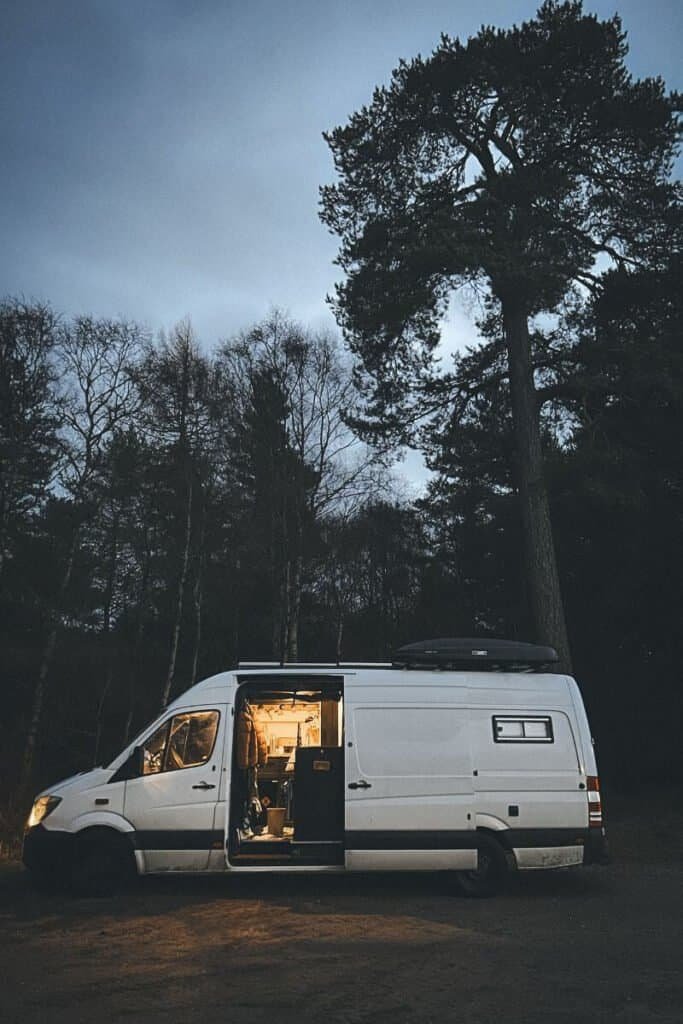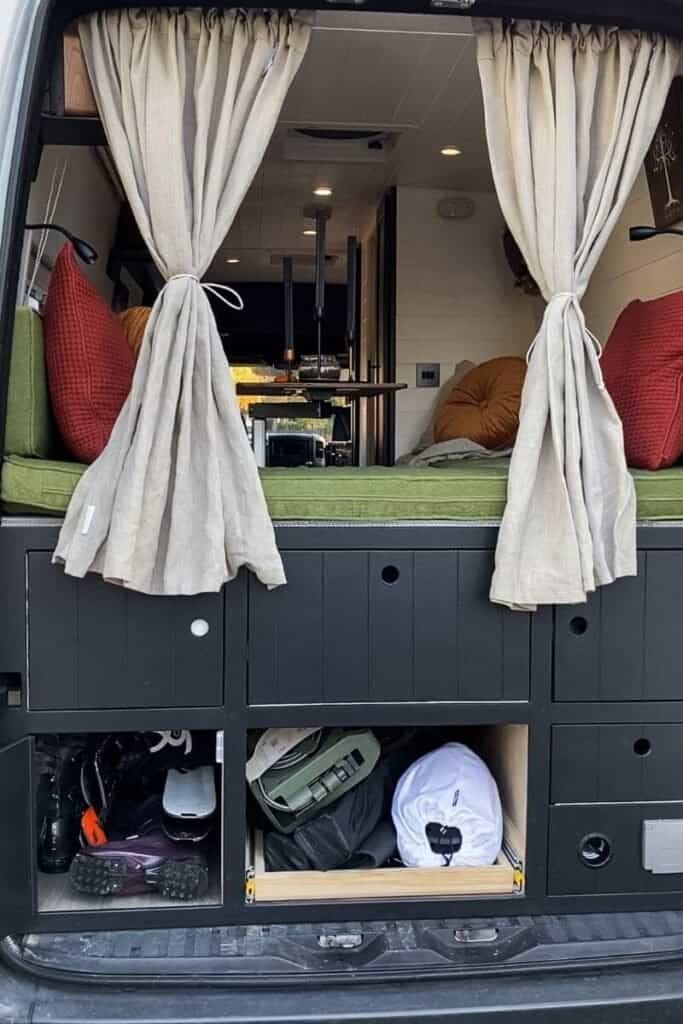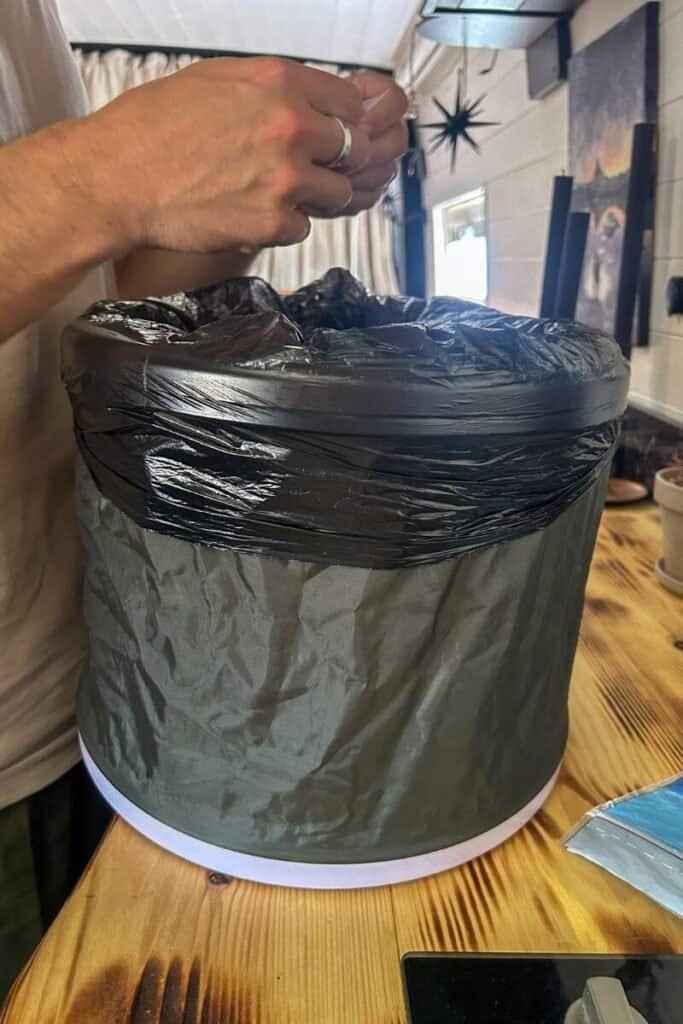Showering on the road is a Hot Topic, We’ll Break Down All Options From No Van Shower to Shower Cubicles With the Pros And Cons of Each.
The allure of vanlife is undeniable: the freedom to roam, the ability to call any scenic spot home, and the simplicity of living with just the essentials. But one of the most hotly debated topics among van lifers is whether to install a shower in their mobile homes. 🚿
As you embark on your vanlife journey, it’s essential to weigh the pros and cons of having a shower in your van and explore the best bathroom options available.
As vanlifers who spend months at a time in our van, like to be off-grid as much as possible and do adventure sports like skiing, surfing and climbing, we have found our wet/dry room indoor shower essential!
But as we also regularly use gyms, 🏋 visit campsites and spot public showers on the road, we can see how easy it would be for many people to do without a shower.
In this blog, we’ll cover the various considerations for installing a shower, introduce you to the most popular vanlife shower setups, and provide alternative solutions for those who prefer to keep it simple.
Whether you’re a weekend warrior or a full-time nomad, our guide will help you make an informed decision about your hygiene needs on the road. 🛀
So, let’s dive in and answer the burning question: To shower in a van or not?
If you’re looking for vanlife tips here’s our guide to Living in a Van!

Where Do You Shower When You Live in a Van?
The main two options when living in a van are to have a shower installed or use public showers, which can be found at campsites, gyms, leisure centres, beaches and fuel stations. 🙌 We have found nationwide gym memberships a great way to make the most of showers on the road.
For those wishing to be more off-grid, here are all of the alternative shower options for vanlifers:
Alternative Shower Options for Vanlifers
For those who prefer not to install a shower in their van, there are several alternatives:
Public Showers
Available at gyms, truck stops, fuel stations, campgrounds, 🏕 leisure centres and hostels. Membership to gym chains like Planet Fitness & Virgin can provide nationwide access.
We have even found small groups of leisure centres like Highlife Highland in Scotland, which are also extremely affordable. And gyms and gym pods all over Norway 🇳🇴 for one membership fee.
With a little research, you may find alternative options in your area.
Natural Water Sources
Rivers, lakes, and beaches can offer a refreshing way to stay clean (just remember to use eco-friendly soap). Beaches also often have public showers and toilets.
This is a great option for those spending most of their time away from urban areas, although a chilly option in cold climates. 🥶️

Wet Wipes and Washcloths
Biodegradable wet wipes and washcloths are a quick and efficient way to freshen up without needing to find a shower.
If you have opted for a sink in your van you can wash your hair in it after a washcloth clean, alternatively, you can use dry shampoo. 🧼️
How Do Vanlifers Find Public Showers?
One of the best vanlife hacks is smartphone apps. 📱 To find showers, water, campgrounds, dumping stations, toilets, laundry machines, free park ups, LPG gas, fuel and anything else you can think of, you’ll want to download our favourite apps:
- Park4Night
- iOverlander
- MyLPG.eu
- Google Maps
Do I Need a Shower in My Van?
Having a shower isn’t a vanlife essential for everybody. If you’re happy to use a washcloth in place of a shower, don’t mind a nature shower or workout at the gym regularly, you may find a shower unnecessary. 🤷♀️
If you don’t fit into any of these categories or you do a lot of sport, having a shower could be important.
Questions to Determine Your Vanlife Showering Needs:
- 🛀 How often do you need to shower? – If you can’t imagine not showering frequently, having one to hand will likely be important, there aren’t always options in remote places.
- 🥵️ What climates will you be travelling in? – Super sweaty in summer or freezing cold outside in winter, think about how this may impact your shower needs and experience.
- 📏 How much space do you have available in your van? – Indoor showers take up a lot of room, can you justify the space within your layout?
- 💰 What is your budget for installation and maintenance? – Your budget will help determine what kind of shower system you can install, plumbing and water heating can be expensive.
- 🚿 Are you comfortable using public or outdoor showers? – If this is a no, then you’re going to want your own shower.
- 💦 Do you have enough freshwater storage? – Showers use a lot of water, work out what system will work best for your lifestyle.
- 😌 How much importance do you place on comfort and convenience? – If you are building a super cosy studio on wheels, a shower room is a luxury and convenient area.
- 🏄 Could you make a shower room versatile? – We do many adventure sports so our shower becomes a place to spray and hang sweaty gear and a heated drying room for wet gear. As a couple, we also like having a private place to go to the toilet.
If you need an in-depth guide on surviving Winter in a Campervan, check out our blog post here!
Is It Worth It to Have a Shower in a Van?
For a lot of vanlifers, it’s not worth having a shower in a van, with easy access to gyms, campsites and other public showers, having one installed is an unnecessary use of space.
For those who wish to spend more time off-grid or do outdoor sports like hiking 🥾 and skiing, a shower is often essential.
We love our shower and think it is worth having. We have somewhere private to use the loo, a hot shower on demand and a heated drying room.
We’re thankful for our shower room, perfect for drying wetsuits and ski gear. This allows us to be adaptable in all climates, from the Swiss Alps to Australia.

4 Best Van Shower Options
If you want a shower solution in your van, these are the 4 best and most common options for vanlifers.
Shower Cubicle
Shower cubicles are essentially miniature versions of household showers installed inside the van. Many vanlifers choose this wet bath option and have their toilet 🚽 fitted inside their shower cubicle.
We have this type of bathroom, without a built-in toilet.
Pros:
- 👩❤️💋👩 Privacy: You have your own private showering space and toilet. This can be a great option for couples.
- ⌚️ Convenience: Always readily available, regardless of location. You just have to wait for the water to heat up, which for us, takes no more than 15-20 minutes.
- 🧖♀️ Comfort: More consistent water temperature and pressure than other vanlife showers.
- 🔥 Versatile: As well as a complete bathroom solution our shower room gets lots of use as a heated drying room. Occasionally, we store things in it when in a hurry and don’t have time to put everything away.
- 🏡 Homely: If you’re designing your dream home, nothing makes it feel more like a little studio on wheels than a built-in shower room.
Cons:
- 🐘 Space: These shower solutions take up the most room, if you don’t have a long-wheelbase van, you might find it a bit of a squeeze trying to fit one in. Even in a large van, the floor-to-ceiling design can make the space feel cramped. Sometimes this can be avoided by the choice of location for your bathroom.
- ⚖️ Weight: Keeping the weight of your van build down will be a constant balance, these types of bathrooms add a considerable amount more to your overall weight.
- 💰 Cost: These are the most expensive vanlife showers to install and maintain.
- 😵 Complexity: Requires plumbing knowledge and sometimes professional installation.
- 🌊 Water: This type of shower uses the most water, you’ll want at least a 60L water tank and the ability to top it up regularly.
Costs:
£1,000 – £5,000 depending on DIY vs Professional and the parts, installation and choice of toilet.
Installation & Maintenance:
Installing an indoor shower involves careful planning and often professional assistance. You need to consider waterproofing, drainage, and ventilation to prevent mould and mildew.
Regular maintenance includes cleaning 🧹️the shower area, topping up the fresh water and emptying your grey water tank.
Overall maintenance will be variable, but generally low if properly installed.
We had to replace our water pump on the road, which wasn’t a massive or costly job, but the location of the pump made it more complicated than it needed to be. 🔧 Think about maintenance access when planning your layout.

How to Turn Your Van Shower Into a Heated Drying Room
Turning your shower cubicle into a drying room is relatively simple. If you plan to duct your heating to various areas of the van, add a vent to the shower cubicle.
Our hot air is distributed to four locations in our van. We adjust the temperature and intensity from our control panel to blast hot air into the shower as needed. 🔥
Hidden Showers
Hidden showers are cleverly integrated into your van’s existing structures, such as a drawer or cabinet, allowing you to pull them out when needed and tuck them away when not in use. 👏
There are so many clever design options for hidden showers, some also include a toilet. This is a great option for those wishing to have an indoor shower, without a full shower cubicle.
Pros:
- 📏 Space-saving: This shower takes up far less room than a full wet bath.
- 😌 Discreet: Keeps your van looking spacious, uncluttered and organised.
- 🤙 Multi-functional: Often integrated into other furniture or storage solutions.
- ⚖️ Weight-saving: Considerably lighter than a shower cubicle.
- 💰 Money-saving: Parts and installation will be more cost-effective than a bathroom.
Cons:
- 😵 Complexity: Can be difficult to design and install.
- ⌚️ Convenience: May require additional steps to set up and tear down.
- 😯 Privacy: A hidden shower doesn’t offer as much privacy as a shower cubicle.
- 💦 Waterproofing: Ensuring the hidden compartment is waterproof can be challenging.
- 🧖♀️ Comfort: Personally, we hate shower curtains, they can stick to your skin when showering and be difficult to get dry.
Costs:
£500 – £3,000 depending on DIY, self-build, customisation and materials inc toilet.
Installation & Maintenance:
Installing a hidden shower involves creative design and possibly custom-built components. Careful attention must be paid to waterproofing and drainage, ensuring the shower compartment remains dry and mould-free.
Routine maintenance includes checking the integrity of seals and the functionality of retractable parts.

Outdoor Showers
Outdoor showers are mounted on the exterior of the van or can be handheld. Wherever they are installed, they can use the same system that heats your kitchen water.
You can also attach a showerhead and hose to your kitchen tap to transform it into an outdoor shower. 🚰
We also have an outdoor shower which allows us to wash off mud or sand without bringing it inside the van. Our hose is tucked away by the back door and the shower head sticks to the window with a sucker.
We have a retractable line for the back doors for drying gear, which could also double up as a place to hang a makeshift shower curtain for more privacy.
Outdoor showers are a great solution in warm climates, I wouldn’t want it to be our only option in chillier locations though. 🥶️
Pros:
- 📏 Space-saving: Doesn’t take up any interior space. Ideal for those in smaller vans.
- ⚖️ Weight-saving: This system would add very little weight to your van build.
- 💰 Cost-effective: Much cheaper than indoor options.
- 👍 Easy Installation: Less complex to set up and no extra compartments to build. You don’t have to consider waterproofing or drainage with this one.
- 🧹️ No clean-up: No need to worry about wiping walls or drying shower curtains.
Cons:
- 🌦 Weather-dependent: It would be challenging to use in inclement weather and wouldn’t be a four-season solution.
- 🤭 Privacy: Less privacy than any indoor vanlife shower options.
Costs:
£50 – £2,000 depending on the setup and water heater requirements.
Installation & Maintenance:
Outdoor showers are relatively easy to install and shouldn’t need much ongoing maintenance. You will have minimal issues if your hot water system has been fitted correctly.

Portable Showers
Portable showers are standalone units which can be used inside or outside the van. They typically consist of a water container, a pump, and a hose with a showerhead.
Other more simple solutions are gravity-fed shower bags. Using this option indoors would still require a waterproof area and drainage system, so these are mostly used as outdoor showers.
The key difference is that they aren’t plumbed into your hot water system and can be used away from the van. For hot water, there are 3 solutions:
- A battery-operated or plug-in option where a heating element will warm the water.
- Boil a kettle and manually add hot water.
- Leave the bag in the sun to warm throughout the day.
Pros:
- 📏 Space-saving: As another outdoor solution this takes up very little real estate within your van.
- 👌 Flexibility: Can be used almost anywhere.
- 💰 Affordability: Budget-friendly option, no need for a shower area, plumbing or hot water system.
- 👍 Portability: Easy to store and transport.
Cons:
- 😵 Convenience: Requires setup and takedown each time.
- 💦 Water capacity: Limited to the size of the water container.
- 🌦 Weather-dependent: Not a four-season option, it would be difficult to use in wild weather.
- 🌡 Temperature Control: It is much harder to get the water to a comfortable showering temperature.
- 🤭 Privacy: Not as private as indoor vanlife shower solutions.
Costs:
£20 – £200 depending on the type you choose.
Installation & Maintenance:
Portable showers require no permanent installation. Simply fill the water container, and you’re ready to go.
Maintenance mainly involves ensuring the pump and hose are clean and in good working order.

Where to Put a Shower in a Van?
When choosing a wet bath shower cubicle or hidden shower for your van, consider its location for functionality, living space, and aesthetics. The 3 most popular options are behind the driver’s seat, at the foot of a rear bed 🛏 or in front of the backdoors.
Here are the Pros and Cons to consider for each of these options:
Behind the Driver’s Seat
Shower cubicles in this space are very aesthetically pleasing and a great use of that open space opposite the sliding door. We love the semi-circular designs, allowing for more bathroom space than rectangular cubicles in the centre of the van.
Hidden showers in this area can be pulled from a drawer, making use of the open space by the sliding door.
We didn’t go for this option as we wanted full access to our cab from inside the van. When in wet, muddy and snowy locations, we use our cab as a mud room to de-layer before climbing into the living space. ☔️
Our campervan also has two captain chairs and an extendable countertop, which gives us more living and working space 💻 in the front of the van as well as the back.
If you’re looking for the best Vanlife jobs, check out our in-depth guide here!
Pros:
- 🦄 Aesthetically pleasing: This area allows the option of creating a gorgeous custom design, not limited to the small boxy showers in the centre of the van.
- 🙌 Use of space: Being by the sliding door, gives you more space to play with and keeps the rest of the van layout more open. This can help the living space feel less cramped.
Cons:
- ⛔️ Cab access: Depending on your design, having a shower at the front may cut off your access to the cab from inside the van. You should consider if this is important to you.
- 🚽 Visible: The first thing people will see when you open the door is the shower cubicle and possibly the toilet.
- 📏 Size: Making a larger shower cubicle, takes up other valuable living space.
- ⚖️ Weight: Going bigger, isn’t better if you don’t have the weight allowance.

In the Centre of the Van
Many people choose to place their shower in the centre of their van. This is often to one side of the aisle, at the foot of a rear bed. Hidden showers are often placed here underneath bench seats or inside drawers.
This is where our van shower is, as we didn’t want the shower cubicle to be opposite or in front of any windows.
This placement also allowed us to utilise the floor-to-ceiling design and add a tall food larder on one side of the shower and a thin stacked wardrobe on the other side.
Having our bed behind the shower creates a cosy space without obstructing the views from the back door.
Pros:
- 🤭 Privacy: Being away from windows which are often at the front and back of the van, makes this location the most private option for your shower.
- 📏 Use of space: You can make the most of the floor-to-ceiling design and add more tall storage solutions.
- 😌 Cosy bedroom: Having tall fixtures at the base of your bed creates a cosy sleeping area, this works great for our movie nights.
Cons:
- 😬 Cramped: Although having the shower cubicle in the centre can create a cosy environment for your sleeping space, it can also make the inside of the van feel cramped.

At the Back
Placing your bathroom at the back of the van gives you more options in terms of size and accessibility. You could create a bathroom the entire width of the van, which could double up as a mud room.
Hidden showers in this area enable an open, flowing living space with views from the windows or when the doors are open.
Pros:
- 📏 Use of space: Having the entire width of the van gives you more freedom with size and design.
- 🥾 Multiuse: Doubling up as a mudroom is a great way to make the space versatile without sacrificing your cab.
- 😌 Organisation: Having the cab and bathroom as closed-off areas allows your living space to be open and more organised.
Cons:
- 😬 Cramped: Having the cab and bathroom as closed-off areas may make your living space feel smaller.
- 🌄 Accessibility: A shower cubicle or bathroom at the back of the van will obstruct views from the back window.
- 🏂 Storage: Placing a shower at the back of your van will take away the option of an easily accessible garage space.
- 📏 Size: Expanding the shower cubicle encroaches on other valuable living space.
- ⚖️ Weight: A bigger bathroom = more weight.

How Much Water Does a Van Shower Use?
If you’re trying to conserve water using a trigger shower head, you can use as little as 5-10L per shower. 💦
If you want the luxury of a free-flowing shower like at home, you’ll be looking at 50-70L per shower. 🌊
For a free-flowing shower that you turn off and on to consciously save water it can be anywhere between these two. ⛲️
We use a trigger head shower and generally keep our showers down to 10-15L for both of us.

Vanlife Toilet Options
The toilet you choose will depend on your lifestyle and how comfortable you are with the built-up mess. The best options for vanlife toilets are:
- Plumbed-in: This is the ultimate luxury in a campervan, an RV toilet takes water from your fresh water tank and deposits it into your black water tank.
- Cassette: These porta-potties have a waste-holding tank which you routinely empty as you need.
- Compost: Composting toilets have risen in popularity recently with vanlifers, they work similarly to a porta potty with the addition of composting materials.
- Pop-Up: We have a Bivvy Loo, a simple camping toilet for #2 that packs away small enough to fit in a cupboard and the only clean-up is discarding the bag.
- Pee Bottles: If you opt for a pop-up or no toilet, you’ll want an option for emergencies or nighttime. Pee bottles are a popular option for this.
- No toilet: For those happy with a trowel and peeing outdoors in wild weather you may find you don’t need a toilet at all!
A Bivvy Loo and pee bottles are the best option for us as we travel during winter, which renders a flushable toilet useless. We rarely visit campsites, so emptying black water on the road would be tricky.
Most of the time, we use public toilets. They are usually easy to find unless you’re in an extremely remote location.

The Wrap-Up | The Best Van Shower Options
Showers can be a polarising topic among vanlifers. Some argue that the freedom and simplicity of not having a shower outweigh the inconvenience, while others swear by their portable or DIY shower setups.
We love our wet bath shower 🚿 room for its versatility, toilet privacy, and heated drying facilities.
Ultimately, the decision to have a shower in your van or not should be based on your personal preferences and lifestyle. But regardless of where you fall on the spectrum, there are numerous options available for staying clean 🧼️ on the road.
From public facilities to creative solutions like solar showers and gym memberships, finding the best bathroom option for your individual needs is key.
So don’t let the lack of a traditional bathroom hold you back from living life on the road in your van – embrace the adventure and find a shower routine that works for you!
Read about our favourite road trips:






